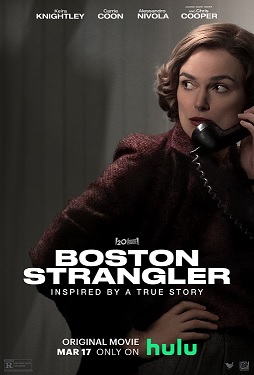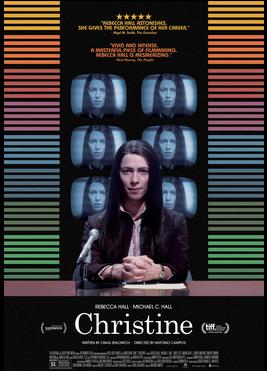In the Boston of the early 1960s, Loretta McLaughlin (Keira Knightley) is a reporter for the Boston Record American. Loretta is frustrated with a newsroom that is dominated by a boys club of aging, overweight, sexist old timers. When she thinks that she’s discovered that there is a murderer targeting and strangling elderly women in Boston, she goes to her editor, Jack Maclaine (Chris Cooper), and asks to be allowed to write up a story about her suspicions. Jack would prefer that Loretta write a story about the new toaster that’s been released by Sunbeam.
So, Loretta does some investigating on her own and she discovers that the police suspect that all of the recent murders are being committed by one man. The story that she writes ends up on the front page and it even leads to her sharing a sip of whatever alcohol Jack has in his flask. The Boston police initially deny Loretta’s story and it looks like Loretta is going to spend the rest of her career reviewing kitchen appliances. But then the police just as suddenly confirm Loretta’s story and Loretta is back on the Strangler beat. She’s partnered with a veteran reporter named Jean Cole (Carrie Coon).
Together, Loretta and Jean battle sexism while investigating not just the Strangler but also the police department’s incompetence. Their reporting makes them local celebrities, with many people coming to them with the leads that the police couldn’t be bothered to follow up on. Despite Jean’s warnings about getting too involved with the case, Loretta obsesses over the Strangler’s crimes. Could the murderer be Daniel Marsh (Ryan Winkles), the boyfriend of one of the victim’s? Could it be George Nassar (Greg Vrostros), a criminal who reportedly has a genius IQ? Or could it be Albert DeSalvo (David Dastmalchian), the man who confesses to the crimes under the condition that his confession cannot be used in court and the belief that his family will be sent the reward money that would otherwise go to someone who helped the police to catch the Boston Strangler? DeSalvo, who was given a life sentence for a series of rapes that he committed before and after the murders began, is never convicted of any of the murders but, with his confession, the murders are declared to be solved. But are they? Loretta is not so sure.
Boston Strangler is not the first film to be made about the murders but I think that it might be the first to seriously explore the theory that DeSalvo was lying when he confessed to the majority of the murders. (As the film points out, DeSalvo’s cellmate just happened to be the same George Nassar who was also a suspect in the murders.) 1968’s The Boston Strangler, for instance, explained away the inconsistencies in DeSalvo’s confessions by suggesting the DeSalvo suffered from dissociative identity disorder and that DeSalvo himself didn’t understand what he was doing. This latest version of the story, however, presents DeSalvo as being a streetwise, lifelong criminal who confessed because his lawyer, F. Lee Bailey, convinced him that he would get a book deal and that he would be sent to a mental hospital as opposed to a prison. A title card at the end of the film informs us that DNA testing has confirmed that DeSalvo committed one of the 13 murders to which he confessed but that the other 12 murders remain unsolved. While one might wonder why anyone would confess to a murder that they didn’t actually commit, it’s actually something that has happened on more than a few occasions. Typically, the false confession will come from someone who, like DeSalvo, is already looking at a life sentence and who has nothing to lose by helping the police close the book on some unsolved crimes. The confessor gets a little extra notoriety and maybe some special treatment and the cops get to increase their clearance rate. In Boston Strangler, it’s suggested that DeSalvo’s confession was accepted because everyone wanted the crimes and the fear that went with them to just magically go away.
It’s an intriguing theory and one that has more evidence to back it up than the majority of conspiracy theories that one comes across online. Unfortunately, Boston Strangler really doesn’t do the story much justice because it focuses on the least interesting part of it. We don’t learn much about the investigation, DeSalvo, or the lives of the Strangler’s victims. Instead, the film gets bogged down with newsroom politics, as Loretta demands to be taken seriously and Jean offers advice on how to play the political game. Every journalism cliché is present, from the crotchety old editor to the afterwork bar to the publisher who doesn’t want to upset the city’s power brokers. Admittedly, when it comes to journalists, there’s probably a good deal of truth to be found in all of those clichés but the film still leans a bit too heavily into them. Every time we see Chris Cooper looking at the front page and taking a sip from his flask, we’re reminded that we’ve seen the exact same scene in a hundred other movies about newspapers.
As directed by Matt Ruskin, Boston Strangler has the washed-out, shadowy look that David Fincher used to good effect in Zodiac. The difference is that, in Zodiac, the shadows created a feeling of an all-enveloping evil slowly consuming the world. Zodiac’s visual style felt as if it was showing the viewer a true picture of the heart of darkness. In Boston Strangler, the visual style just leads the viewer to suspect that the director watched Zodiac before filming. The film’s visuals are so washed-out that it actually becomes a bit boring to look at. This is the rare film that makes Boston seem bland. Interestingly, when the action briefly moves to Michigan, the visuals suddenly become much more colorful and interesting. Perhaps by design, there’s a vibrancy to the Michigan scenes that is missing from the rest of the film. Unfortunately, those Michigan scenes are very brief.
The cast is full of talent but the majority of the performers are let down by a script that doesn’t allow anyone to have more than one or two personality traits. Keira Knightley speaks with a convincing Boston accent and has a few good scenes in which she shows that Loretta is coming to understand the true horror of the story she’s covering but the script itself doesn’t allow Loretta to have much of a personality beyond being outraged. Carrie Coon, cast as potentially the most interesting character in the film, also feels underused. As for Chris Cooper, he glowers with the best of them but the film can’t figure out much to do with him beyond having him drink from his flask.
There’s an interesting moment in the film in which it is suggested that DeSalvo built a false confession out of the details that he came across in Loretta and Jean’s stories about the crimes. It’s a moment that suggests that the media itself has some culpability when it comes to the crimes of men like Albert DeSalvo and whoever else may or may not have been strangling women in 1960s Boston. It’s perhaps the most honest moment of the film but it’s also a moment that’s not followed up on. That’s a shame because it suggests the movie that Boston Strangler could have been if it hadn’t gotten so bogged down with all the journalism film clichés. (Again, I would mention Zodiac as the prime example of how to do this type of film effectively.) Boston Strangler hints at the bigger story but it never really goes far beneath the surface.


